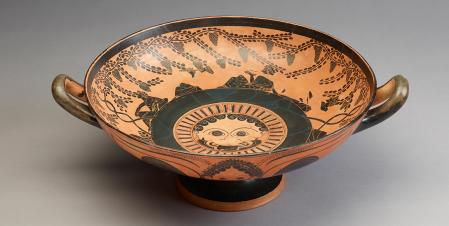Archaeology, Global Art, Applied Arts

Griechenland, attisch, Anonym
Große Augenschale, 520-510 v.Chr.
The collection of objects from various world cultures in the Museum Folkwang goes back to Karl Ernst Osthaus. The first acquisitions date back to 1898 and initially concentrated on Islamic art. With the idea of founding a museum of decorative arts, Osthaus' interest expanded around 1900 to include East Asia, antiquity and European decorative arts. At the Folkwang in Hagen, which opened in 1902, the collection was initially exhibited together with the fine arts for financial reasons, but the museum soon became characterised by a presentation that transcended genres and epochs. Around 1912/13, the collection was enriched by Africana, and around 1914/15 a group of oceanic cult objects was added. After the transfer of the holdings, the collection in Essen was enriched from 1922 until well into the 1970s. The collection is no longer expanded.
HISTORY
From the very outset, Karl Ernst Osthaus also focused the collecting activities of the museum he founded on the applied arts and on archaeology. Osthaus recognized and followed parallels between the fine arts and arts and crafts. Two trips in rapid succession in 1898 and 1899 awakened his enthusiasm for the Islamic cultures of the Mediterranean. His first purchases date, as we now know, from this period. The focus of the collection was later expanded along lines that were largely geographical, with the result that today it comprises objects from Europe and even further afield covering all kinds of different periods. Under Osthaus, the intention, by presenting these contemporary objects at Museum Folkwang, was not only to send out new impulses to contemporary art but also to provide local industry, for example the silversmiths’ trade, textile and ceramic processing companies, with examples and quality standards. The directors of Museum Folkwang who succeeded Osthaus also felt an obligation to build up this department. In the 1920s, Ernst Gosebruch followed in the footsteps of Osthaus‘ collecting tradition by making select purchases; further important additions were made in the period following World War II, particularly in the 1960s.
COLONIAL HERITAGE
The Museum Folkwang actively engages with the discourses surrounding racism, Germany's colonial past and the role it itself played in it as a cultural institution. Our collection contains numerous objects that originate from colonial contexts, for example from present-day Nigeria or New Guinea. In line with the guidelines of the German Museums Association and the so-called 3-way strategy adopted by the Federal Government, the Länder and the leading municipal associations in October 2020, we strive to appropriately reappraise our holdings and our history. We are open to an exchange with the societies of origin of the objects we hold today. We are grateful for any information and suggestions.
OVERVIEW
After losses due to the Degenerate Art campaign and the Second World War, today's holdings comprise around 1700 inventory numbers, whereby according to current estimates around 90% of the objects can be traced back to Karl Ernst Osthaus. In addition to ceremonial equipment and cult figures, the collection contains decorative art objects from a variety of cultures, in particular vessels, architectural jewellery and textiles. The collection focuses on Islamic and East Asian art.
IMAGE ENQUIRIES
Image enquiries via www.artothek.de
CONTACT
Dr. Nadine Engel
T +49 201 8845 101
nadine.engel@museum-folkwang.essen.de
Share on
